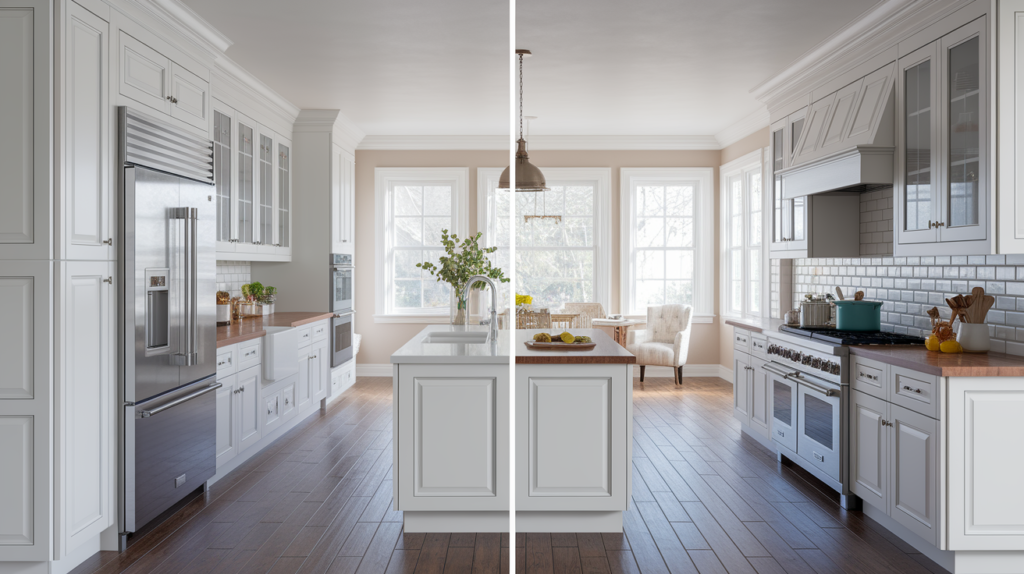
Kitchen remodels are one of the best investments you can make in your home—but only if you get the layout right. A beautiful backsplash or premium cabinetry won’t matter much if your kitchen feels cramped, chaotic, or inefficient. Whether you’re planning a full remodel or a simple upgrade, steering clear of these common kitchen layout mistakes can save you time, money, and daily frustration.
TLDR – Quick Guide
Avoid these seven kitchen layout mistakes to keep your cooking space functional and fabulous:
- Not considering the kitchen work triangle
- Ignoring storage optimization
- Overlooking traffic flow
- Poor appliance placement
- Inadequate lighting
- Skimping on counter space
- Forgetting about outlets
Let’s break it down.
Detailed Breakdown
1. Ignoring the Kitchen Work Triangle
The stove, sink, and refrigerator form the “work triangle.” If these three points are too close together or too far apart, your kitchen workflow will suffer. A cramped triangle means bumping into counters or appliances; too wide, and you’ll feel like you’re sprinting between tasks. Aim for a balanced layout where each element is accessible but not crowded.
2. Poor Storage Planning
A kitchen with too few cabinets or drawers will quickly become cluttered. On the flip side, placing storage too high or too low makes daily use a hassle. Make use of corner cabinets, pull-out shelves, and vertical storage to maximize every inch. Think about how often you use items and store them accordingly.
3. Overlooking Traffic Flow
Kitchens aren’t just cooking zones—they’re high-traffic areas. Placing islands too close to counters or having doors that open into walkways creates bottlenecks. Leave at least 42 inches of clearance for walkways and consider how multiple people will move through the space.
4. Misplacing Appliances
Putting a dishwasher next to a wall? Disaster. Installing a fridge that opens against the counter? Frustrating. Appliances need clearance to open fully and shouldn’t block essential pathways. Always measure swing space before installing anything.
5. Inadequate Lighting
A single ceiling fixture won’t cut it. Good kitchens use layered lighting: task lighting for work zones, ambient lighting for general use, and accent lighting for visual appeal. Under-cabinet lights are a simple way to boost visibility where it matters most.
6. Not Enough Counter Space
Countertops are prime real estate. Between prepping, cooking, and plating, you need room to work. If possible, extend counter space by adding an island or a breakfast bar. Even a small peninsula can make a big difference.
7. Lack of Electrical Outlets
You need outlets for mixers, blenders, toasters, and charging stations. Don’t make the mistake of underestimating how many you’ll need—or where. Plan outlets near workspaces and consider adding USB ports for convenience.
Key Takeaways
- Prioritize the kitchen work triangle to improve efficiency.
- Design smart storage systems to avoid clutter and backaches.
- Maintain wide walkways for better movement and flow.
- Plan appliance placements to avoid blocked paths and awkward angles.
- Use multiple light sources to brighten workspaces and elevate style.
- Maximize countertop space to support your daily cooking needs.
- Add outlets generously and strategically for practicality.
FAQs
1. What is the kitchen work triangle and why is it important?
The kitchen work triangle connects the stove, sink, and refrigerator—the three busiest areas in a kitchen. A well-designed triangle boosts efficiency and comfort while cooking.
2. How much space should I leave between kitchen counters and islands?
At least 42 inches of space is recommended between counters and islands. This ensures easy movement, especially if multiple people are using the kitchen at the same time.
3. Can I fix kitchen layout issues without a full remodel?
Yes! Small changes like adding portable islands, under-cabinet lighting, or reorganizing storage can improve functionality without a major renovation.
4. How do I know if I have enough kitchen outlets?
If you’re constantly unplugging one appliance to use another, you’re short on outlets. A kitchen should have one outlet every four feet along the countertop and extras near islands or workstations.
5. Is open shelving better than cabinets?
Open shelving adds visual interest and easy access, but it can also lead to clutter. Use a mix—keep essentials in cabinets and display stylish items on open shelves for balance.
